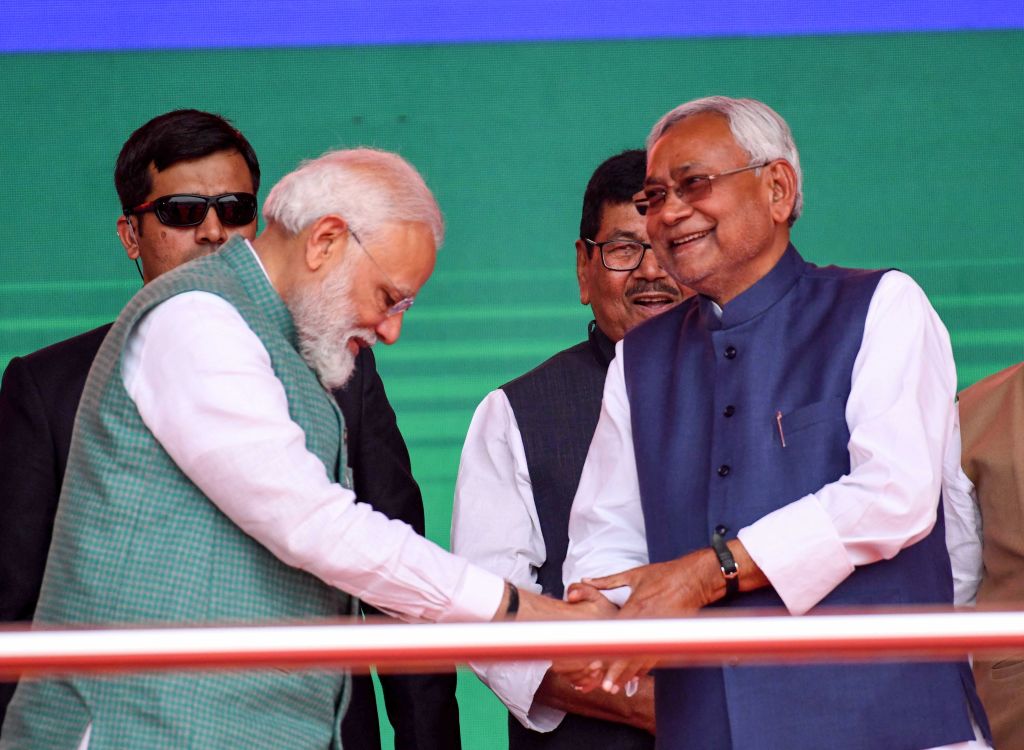- Saturday, April 20, 2024

By: Shubham Ghosh
For India’s ruling Bharatiya Janata Party (BJP), Bihar in the country’s north is not just a state but rather a state of pain. The saffron party has found itself at the receiving end of the shrewd politics of Nitish Kumar, the state’s long-serving chief minister. The Janata Dal (United) (JDU) leader has already played the game of dumping the BJP more than once, with the latest episode unfolding in August last year when he joined hands with old foes Rashtriya Janata Dal (RJD) to form a new government.
The BJP, if reports are to be believed, is working on a strategy of building a coalition one — a rare one featuring the upper castes and a majority of backward classes in the state to beat the RJD-JDU alliance, which had humbled the former in the 2015 state elections.
It is not that the events that happened since that election went against the BJP always. In 2017, Kumar had dumped the RJD to return to the BJP’s fold which it had alienated in 2013 to form a new government. In 2020, the JD(U) did unsatisfactorily in the state polls but still managed to form a government along with the BJP. And then the big blow came for the BJP in 2022.
While the RJD of former Indian railway minister Lalu Prasad Yadav, one of the Hindi heartland’s biggest secular forces in the past, is the strongest party in Bihar’s ruling alliance at the moment, the BJP is of the opinion that it could taste a major success by dismantling the support base of Kumar’s JDU, which has enjoyed the support of many non-Yadav backward castes and Dalit (lowest stratum of castes in India) communities.
It is not without a reason that the BJP’s top leadership has focused on Mauryan emperor Ashoka who had originated from these parts and was one of the subcontinent’s most powerful rulers. India’s home minister Amit Shah has been making frequent visits to the state and his programmes are seen as part of the BJP’s ambitious drive to woo the numerically strong Kushwaha community, which believes that Ashoka had descended from their stock.
The Kushwaha community, which is believed to be around seven to eight per cent of Bihar’s population and the second highest after the Yadavs, has often backed Kumar in elections.
The saffron party has even appointed a Kushwaha — Samrat Choudhary — as its state unit chief, making it amply evident that it is not leaving any stone unturned to woo the community.
According to Choudhary, Kumar has done little for the Kushwahas and only “betrayed” it, asserting that his party will gather support from various communities in the state that sends 40 members to the Lok Sabha or Lower House of the Indian parliament.
With both the Yadavs and the Kurmis, the caste Kumar comes from, having had their chief ministers, there is a view among the Kushwahas that it is their turn now. The BJP may exploit this to its advantage, party leaders said.
Nagmani, a veteran Bihar politician and a bitter critic of the RJD-JDU leadership, said people are fed up by the over-three-decade rule of “Lalu-Nitish”. The Yadavs and the Kurmis have had their share in power but the Kushwahas have been left behind, he said. He also hails from the Kushwaha community.
Besides working on getting the Kushwahas’ support, the BJP is working on a wider plan to expand its support base among many numerically smaller castes — clubbed under the extremely backward class (EBC) — that together counts a lot in swinging the balance of elections.
That is why, a BJP leader noted, the party nominated Shambhu Sharan Patel to the Rajya Sabha last year. Patel enjoyed little recognition within the party’s own organisation but the fact that he came from the Dhanuk caste, a part of the EBC, tilted the scale in his favour.
The BJP’s perceived outreach to parties such as the Vikassheel Insaan Party headed by Mukesh Sahani, who claims to represent numerous subcastes that traditionally worked as boatmen, are seen as part of this effort.
It has also maintained cordial ties with Lok Janshakti Party (Ram Vilas) leader Chirag Paswan who enjoys traction among the Paswans, the most populous Dalit community in the state.
While ‘upper castes’ and most of the backward classes have come together in backing an alliance, as seen during the long BJP-JDU tie-up under Kumar’s leadership, they have traditionally been backers of different parties.
The BJP has now set its eyes on achieving the rare feat of bringing them together in supporting the saffron party.
It is likely to continue with its political outreach to such communities to ensure that its support base is strong enough to ensure that factors like prime minister Narendra Modi’s appeal makes maximum impact in the state, as often seen in neighbouring Uttar Pradesh.
In Uttar Pradesh, it has succeeded in stitching together a rainbow social combination of ‘upper’ castes, a majority of backward communities and a large chunk of Dalits to quell any united opposition challenge, as seen in the 2019 polls when the Samajwadi Party and the Bahujan Samaj Party joined hands.
In Bihar, the backward castes have been traditionally with “Mandal” parties of socialist stock, a pattern the BJP is trying hard to break for the coming polls.
Just as in 2014, the BJP is likely to fight the 2024 Lok Sabha polls largely on its own in the state with alliance with relatively smaller parties.
However, unlike in 2014, the RJD and the JDU are set to be together this time, along with the Left parties and the Congress.
The BJP-led National Democratic Alliance (NDA) had won 31 of the state’s 40 seats in 2014 with nearly 39 per cent of the votes. Political watchers believe that a similar sweep next year will require the addition of more votes against a combined opposition.
(With PTI inputs)
![]()